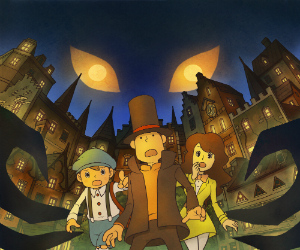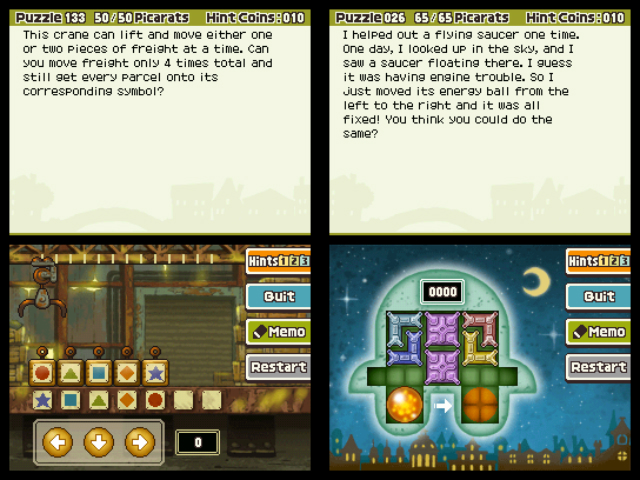Professor Layton and the Spectre’s Call Review
 Game: Professor Layton and the Spectre’s Call
Game: Professor Layton and the Spectre’s Call
Developer: Level-5/Brownie Brown
Publisher: Level-5/Nintendo
Available on: Nintendo DS Only
You know a game series has crossed right over into the mainstream when you see an advert pop up on prime-time TV, invariably showing some culturally diverse pop combo or celebrity family pretending to play a DS or Wii in their impossibly angular luxury environment. It makes me sick seeing Harry Redknapp working for Nintendo, sick to the pit of my stomach, but it is also quite heartening when you are nodding off through Coronation Street and a game engineered by legendary Japanese indie developer Level-5 pops up on your tube.
This is because, despite its unusual art style and, at times, quite dark plot lines, with its winning combo of puzzle solving, quirky storytelling and likeable characters, Professor Layton and his series of touch screen mysteries are mighty popular, and big business. What we have here is the fourth game in the series to have been released on these shores and while the top hat wearing sleuth has not ventured over into 3D yet, this still promises another top drawer mix of oddball goings-on and brain teasing action. How does it measure up to his previous outings?
STORY: Dubbed a prequel to the events of the very first Mysterious Village Layton puzzler, Spectre’s call is the start of a new trilogy of games and takes us back to the time before the esteemed Professor had met his chirpy assistant Luke Triton. This time around, the Prof ends up in the fictional English town of Misthallery, where locals speak in hushed tones of an ominous spectre in the village, a spectre which attacks townsfolk at night. Layton enlists the help of an assistant called Emmy, and, of course, eventually hooks up with young Luke, and together the plucky trio try and solve the dark mysteries of this odd little place.

GRAPHICS: From the first time I saw the little Citroen 2CV chugging along, I have been utterly enamoured with the art style of the Professor Layton games. Level 5 seem to imbibe their little world with a crooked, offbeat charm that evokes comparisons with the likes of Sylvain Chomet’s sublime Les Triplettes De Belleville and even the works of Hayao Miyazaki. There is as much joyous imagination on display here as you could wish for, some wonderfully spooky settings, a grotesque menagerie of villagers, and some super anime-style cutscenes. The in-puzzle graphics are all charming and workmanlike enough to illustrate things perfectly. As DS games go, this looks as good as any of them.
SOUND: From Herschel Layton’s soothing voice, to the blinding orchestral compositions, the sound is of a very high quality. When originally released in Japan (way back in 2009!), the soundtrack was highly praised, none more so that the terrific “Spectre’s Theme” which was certainly buried inside my head for a while.
GAMEPLAY: The core gameplay of the series has not altered much since its inception. The plot is used as an excuse to undertake a series of puzzles, which are accessed by speaking to characters you encounter along the way, or are hidden away in the scenery for you to root out with the stylus. It is classic point and click adventure stuff on the controls front, and is very easy to pick up. There are Hint Coins that can be used to purchase little pointers on how to solve each puzzle, and you are awarded points, or Picarats as they are called, for completing each one. Failure to successfully solve a puzzle on the first attempt means that the total number of Picarats you can win will reduce. From an completionist point of view, most players will want to progress through the game unlocking all of the puzzles and achieving maximum points, however you don’t actually need to do that to complete the game.

The puzzles themselves get progressively harder as the game goes along. There are all manner of puzzle types to solve, one moment you will be solving a mathematical teaser, the next trying to guide a man down a route toward a goal without retracing your steps. There are sliding tile puzzles, block-pushing puzzles, stuff involving playing cards, and many more; the trouble is, it is clear that Level-5 are slowly running out of ideas. Most of the puzzles are rehashed from previous games in the series, and at times it seems as though they have overstretched themselves with logic puzzles that don’t make much sense at all.
LONGEVITY: There is a lot of Layton to play through, with 200 puzzles, minigames to enjoy (I particularly loved shooting mice, but be careful not to pop a cap in Toppy), and the promise of weekly downloadable puzzles such as those available for previous games. This would be fine, and in line with the three preceding games, until you take a look at what gamers in other non-European regions get when purchasing the same game.
That’s right, US and even PAL Australian Layton fans get an additional tagged on mode called “London Life”, which promises 100 hours of Layton-themed, Sims-esque RPG gaming from Mother 3/Blue Dragon Plus developer Brownie Brown. “translation and localisation” issues were cited as the reason for the non-inclusion of this interesting looking extra game, which is ludicrous when you consider they have had two years to port the game across from the original Japanese.

VERDICT: Rather than continue to improve with each game, Spectre’s Call merely chugs along at the same pace as its predecessors, trotting out similar puzzles and following the same format. While the story, the aesthetics and the often wildly funny script are as entertaining as ever, it is clear that our much loved Professor and his crew need a bit of a re-think. Just imagine the possibilities that the stereoscopic 3D could bring to the puzzles. The depth of vision and way that it can be used has been shown to good effect in the recent Mario 3D Land, and there is no reason why a company as adept at squeezing graphical power out of a console as Level-5 are could not use this to their advantage. Not a poor game by any means, just not the forward step I was expecting. And for those able to do so, I would greatly advise importing the region-free American version to have a look at what looks like a highly intriguing additional mode.





